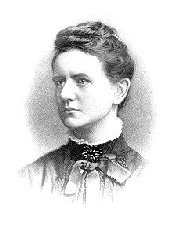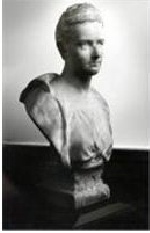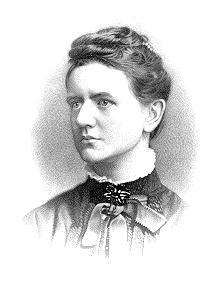
Constance Caroline Woodhill Naden was born on 24th January 1858 at 15 Francis Road, Edgbaston. Due to the death of her mother a mere fortnight after giving birth to her, little Consie was brought up by her maternal grandparents in nearby Pakenham House on the corner of Charlotte Road and Pakenham Road, where there is a blue plaque commemorating her life.
It was here that she developed a habit of voracious reading, thanks to a large miscellaneous library, the property of her grandfather, Mr Woodhill. Described by a cousin as ‘a quaint, retiring, meditative and silent child’ she was educated at a small private day school in Frederick Road and then in 1881 she was enrolled in Mason Science College, later Birmingham University, where she was the first female Associate. Here she came under the influence of Dr Robert Lewins, who founded a gold medal, the Constance Naden medal, in her honour. In 1887 she won the ‘Heslop Gold medal for her essay’ Induction and Deduction’.
Said to have inherited her sense of humour from her mother herself-
Her poem ‘The Pantheists’ Song of Immortality’, containing the line ‘Look in her face and lose thy dread of dying;’ was described by W. E. Gladstone, no less, as ‘a short but singularly powerful production’. Thought of more often as a poet, she was deeply interested in both science and philosophy.
A rational atheist, she wrote widely on Hylo-
Dr Clare Stainthorp
Used by Permission
In the decade after Constance Naden’s death in 1889 she became, in some circles, a cautionary tale about the plight of the intellectual woman. As a result of an inflammatory letter written about her by one of the most prominent thinkers of the Victorian age she came to represent how women became a danger to their own health if they chose to pursue a life dedicated to thought and learning.
Today Naden is best known, if at all, as a poet. In her lifetime and immediately after, however, she was rightly celebrated by many as a trail-
Her death at the age of thirty- minine organization will not bear without injury more or less profound’. Spencer thus had the temerity to suggest that Naden – accomplished poet, philosopher, and scientist – died of complications to do with ovarian cysts because her body could not support the brain work that she had been undertaking with such confidence and ability.
minine organization will not bear without injury more or less profound’. Spencer thus had the temerity to suggest that Naden – accomplished poet, philosopher, and scientist – died of complications to do with ovarian cysts because her body could not support the brain work that she had been undertaking with such confidence and ability.
This, unsurprisingly, angered many people. Madeline Daniell, Naden’s great friend and travelling companion, wrote one letter of rebuke. She stated in no uncertain terms that ‘Miss Naden’s lamented death was not caused by her exceptional mental development’, indeed ‘It was the strength and healthiness of her brain which kept her spirits even, and allowed her to work without evil effects’ during her protracted illness. She argued that such ‘highly developed mental powers’ may only be conceived of as ‘abnormal’ in that they are not common in men or women. Daniell was clearly aware of the potential damage caused by these claims from the pen of such a high-
It was not only Naden’s friends that were outraged. After Spencer’s letter was printed in some newspapers several individuals felt compelled to respond. Some did so with humour. ‘Lætitia’ wrote to the Women’s Penny Paper with an amused but critical attitude, asking ‘Mr Spencer what ought women to do, to whom Nature has been so unkind as to bestow on them mental gifts rare in both sexes? In what way ought they seek to rectify this unaccountable oversight?’. Others attacked Spencer more directly. An anonymous male correspondent wrote to a Scottish newspaper, berating the way Spencer ‘seizes the golden moment’ of Naden’s death to ‘read the ambitious sex a homily’. He remarks that Spencer ‘strangely enough, forgets that he himself has been an invalid the greater portion of his life […] and that he has thereby unfitted himself for fatherhood as much as the most abandoned feminine savant ever unfitted herself for motherhood’.
This latter observation gets to the heart of many people’s problem with women’s education during the late Victorian period. During the second half of the nineteenth century opportunities for women to attend higher education institutions were rapidly increasing: during the 1870s seven trail-
Even some of the people closest to Naden were inclined to agree. Her friend and biographer William Hughes was not obviously enraged and instead supported Spencer’s assertion about the female body’s inability to sustain masculine intellect alongside good health. An 1891 article about Naden’s life and works made this even more explicit, turning Naden’s life and tragically early death into a cautionary tale intended to dissuade other women from similarly pursuing their intellectual interests.
The anonymous reviewer wrote: ‘To tell the truth […], a young woman who is troubled about the mystery of things will usually find the best answer in a house to keep and children to bring up, and a husband to control. If we had fewer educated unmarried women, we should have much less yearning, and much less of the poetry of detachment. […] Thinking of this young lady dead almost before the death of youth, […we] may regret, vainly and foolishly, perhaps, what seems a waste of life to many; a career, a mode of thought, common enough to-
Despite the developing strength of the women’s rights movement and continued expansion of educational opportunities for women across the 1890s and into the twentieth century, there continued to be publicly expressed wariness regarding the negative repercussions of such intellectual development. Well over a decade after Naden’s death Havelock Ellis deemed it ‘worthwhile to quote’ in full Spencer’s assessment of Naden as a footnote to his observation that women’s brains are not well-
The idea of women being a danger to themselves by not following some men’s advice about what was ‘best’ for their mind and body has been a persistent one. In the case of Naden this assessment came to overshadow her many achievements. Spencer’s voice became louder and more persistent than her own, diluting any dangers Naden’s often radical writings might have posed towards the patriarchal society in which she lived. It is only in recent decades that Naden’s place in the history of thought has begun to be re-
The Birmingham Civic Society
Click to enlarge



